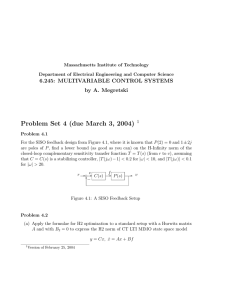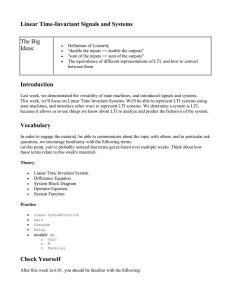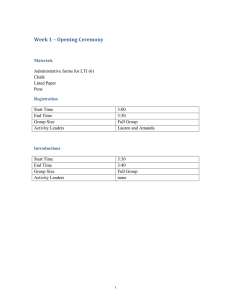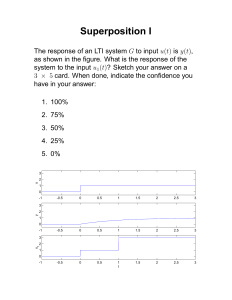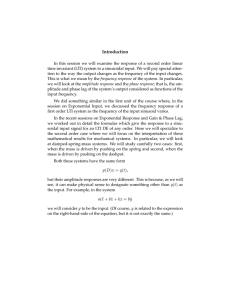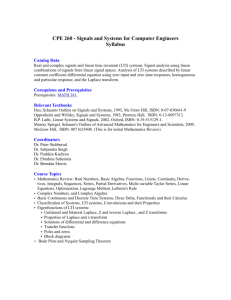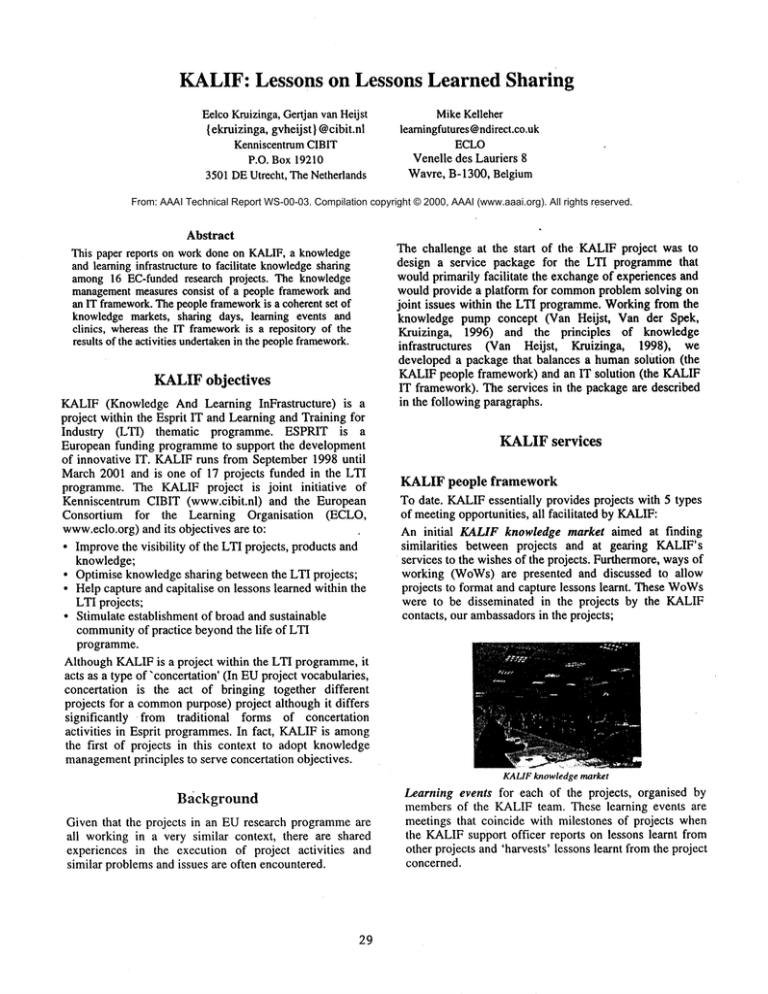
KALIF:Lessons on Lessons Learned Sharing
EelcoKruizinga,Gertjanvan Heijst
{ekruizinga, gvheijst} @cibit.nl
KenniscentrumCIBIT
P.O. Box 19210
3501DEUtrecht, The Netherlands
MikeKelleher
ieamingfutures@ndirect.co.uk
ECLO
Venelle des Lauriers 8
Wavre, B-1300, Belgium
From: AAAI Technical Report WS-00-03. Compilation copyright © 2000, AAAI (www.aaai.org). All rights reserved.
Abstract
This paper reports on work done on KALIF,a knowledge
and learning infrastructure to facilitate knowledge
sharing
among16 EC-fundedresearch projects. The knowledge
management
measuresconsist of a people frameworkand
an IT framework.Thepeople frameworkis a coherent set of
knowledgemarkets, sharing days, learning events and
clinics, whereasthe IT frameworkis a repository of the
results of the activities undertakenin the peopleframework.
KALIF objectives
KALIF(Knowledge And Learning InFrastructure)
is
project within the Esprit IT and Learning and Training for
Industry (LTI) thematic programme. ESPRIT is
European funding programmeto support the development
of innovative IT. KALIFruns from September 1998 until
March 2001 and is one of 17 projects funded in the LTI
programme. The KALIFproject is joint initiative
of
Kenniscentrum CIBIT (www.cibit.nl) and the European
Consortium for the Learning Organisation
(ECLO,
www.eclo.org)and its objectives are to:
¯ Improvethe visibility of the LTI projects, products and
knowledge;
¯ Optimise knowledgesharing between the LTI projects;
¯ Help capture and capitalise on lessons learned within the
LTI projects;
¯ Stimulate establishment of broad and sustainable
communityof practice beyondthe life of LTI
programme.
Although KALIFis a project within the LTI programme,it
acts as a type of’concertation’ (In EUproject vocabularies,
concertation is the act of bringing together different
projects for a commonpurpose) project although it differs
significantly
from traditional forms of concertation
activities in Esprit programmes.In fact, KALIFis among
the first of projects in this context to adopt knowledge
management
principles to serve concertation objectives.
The challenge at the start of the KALIFproject was to
design a service package for the LTI programme that
wouldprimarily facilitate the exchangeof experiences and
would provide a platform for commonproblem solving on
joint issues within the LTI programme.Workingfrom the
knowledge pump concept (Van Heijst, Van der Spek,
Kruizinga, 1996) and the principles
of knowledge
infrastructures
(Van Heijst, Kruizinga, 1998),
developed a package that balances a humansolution (the
KALIFpeople framework) and an IT solution (the KALIF
IT framework). The services in the package are described
in the following paragraphs.
KALIF services
KALIF people framework
To date. KALIFessentially provides projects with 5 types
of meetingopportunities, all facilitated by KALIF:
An initial KALIF knowledge market aimed at finding
similarities
between projects and at gearing KALIF’s
services to the wishes of the projects. Furthermore,waysof
working (WoWs)are presented and discussed tO allow
projects to format and capture lessons learnt. These WoWs
were to be disseminated in the projects by the KALIF
contacts, our ambassadorsin the projects;
KALIF
Background
Given that the projects in an EUresearch programmeare
all working in a very similar context, there are shared
experiences in the execution of project activities and
similar problemsand issues are often encountered.
29
knowledge
market
Learning events for each of the projects, organised by
members of the KALIFteam. These learning events are
meetings that coincide with milestones of projects when
the KALIFsupport officer reports on lessons learnt from
other projects and ’harvests’ lessons learnt from the project
concerned.
Sharing days. Where projects come together for sharing
days, commonissues are related to the very specific
context of the commonresearch action line and its
objectives. These events are highly participative focusing
closely on the real issues faced by those present. Together
with the recently introduced clinics, the workshopsprovide
an opportunity to build a sense of mutualtrust betweenthe
projects and KALIFand amongthe projects themselves;
Clinics. KALIF also offers customised support to
individual projects in LTI programmewide areas such as
marketing, intellectual property rights and evaluation.
KALIF IT framework
Further to the facilitated meetings, the KALIFweb site
(www.kalif.org) offers registered users from the projects
¯ the followingbasic functionality:
A knowledge map. A web based application that makes it
easy to find people in the project teams by their knowledge
and experience. The map provides facilities
to find
institutions and companiesthat are linked to the projects.
Furthermore, the mapprovides a detailed summaryof the
projects.
A document repository. A document base that allows the
knowledge-guided retrieval of documents. This document
base is intended for both internal (the projects) and
external (a wider audience) use. One important set
documentsin the repository is the collection of lessons
learned documentsgenerated during the learning events.
A lessons learned document consists of the following
attributes:
¯ A status field (to be approved by source, approved by
source);
¯
A distribution field (indicating the distribution level of
the lesson, e.g. project consortium,
the LTI
programme,ECprojects, public);
¯
A source field (nameof the source);
¯
An author field (nameof the author);
¯
A sharing area field (containing the name of the
sharing area to whichthe lesson pertains)
¯
A topic field (containing a short description of the
topic of the lesson);
¯
A one liner field (a single sentence describing the
lesson);
¯
A context field (containing a detailed description of
the lesson).
As an example of the relation between the people
frameworkand the IT framework, the value in the sharing
area field refers to the sharing areas that were identified in
the knowledge market. Furthermore, during learning
events, the KALIFfacilitator that guides the debriefing
process uses the sharing areas as promptsto elicit lessons
from the projects.
A news and calendar service.
The web site has a
comprehensive calendar of forthcoming conferences,
30
workshops and trade shows, and has a news repository,
that also contains issues of the LTimes, the electronic
newsletter compiled by the KALIFteam. This news and
calendar service has a public part, so that outsiders to the
projects are able to viewparts of this information.
Discussion facilities The KALIFweb site allows electronic
discussion between the people working in the different
projects.
KALIFweb site
The KALIFweb site is built on a Lotus Dominoplatform,
and uses Muscat indexing and search facilities. Recently,
the KALIFproject has launched a portal site (www.ltiportal.org), using the same Lotus Dominoplatform that
allows the general audience to inspect the public parts of
the original KALIF
site.
KALIFdissemination services
KALIFalso helps to collect and package of products from
the meetings and web site in order to leverage these to a
wider audience. As the LTI programmeis not a standalone exercise, KALIF will package and summarise
knowledgeproducts for a wider audience in a format that
is comprehensible to non-experts. The KALIFwebsite is a
majormeansfor doing so, but a ’wallet’ filled with leaflets
on the LTI projects is also being produced. The other way
round, KALIF collects
and packages, through an
observatory, relevant developments from in- and outside
the ECthat will be captured and fed back into the projects
via the website and the meetings. Also, special exhibition
booths have been developed to serve as a promotion
toolbox for the joint projects.
Key data
To date, 154 project members have subscribed to the
KALIFweb site, accessing it 500 times/month on average.
This user communityrepresents over 100 organisations in
Europe, spread over 15 countries.
The KALIF team
consists of 5 persons, 3 of whichreside in an office in the
Netherlands, and 2 reside in two places in the UK. The
KALIF has a labour budget of 46 person months,
stretching over a period of 36 months,and a total financial
budget of 660.000 Euro, roughly 660.000 USdollar.
During the initial knowledgemarket, 8 sharing areas were
identified to which later a ninth was added. The sharing
areas were elicited
by a process in which project
representatives were asked what they had on offer for
sharing and what they would like to bring homefrom the
market. These sharing areas became the organising
principle for the KALIFweb site as well as became the
focal point for learning events, sharing days and clinics.
The KALIF team has organised 6 sharing days and 10
clinics. During learning events, on average 20 lessons
learned documents were reported. Hitherto, 15 learning
events have been held. The lessons learned were
categorised in 9 sharing areas.
Lessons learned
We have recently begun the important process of
evaluation of KALIFagains t its original objectives and
have gained insights into how the projects viewed KALIF
in its initial efforts to communicate
its ambitions.
The evaluation frameworkwe use basically comprises of a
set of performance indicators per objective, performance
criteria per indicator and of course performancestandards
per criterion. Four streams of input feed the evaluation
process:
Systematic collection of so-called ’chronicles’, reports on
all activities in the people framework;
Measurementof web activity, in terms of numberof hits,
origin of hits, downloads,etc.;
Evaluation ’exit interviews’ with project managersand/or
KALIFcontacts, 4-6 weeks before project is closing.
Probes during these interviews are: Intuition, perception
and attitude, Learning and KnowledgeSharing, Economic
Effectiveness and Impact;
Collection of expert opinions on e.g. web usability.
Frankly, at the start of the project, KALIFwas seen as a
tax - a burden, and additional bureaucracy imposed upon
an unwilling community.This reflects the fact that it is not
always natural for a group of projects to start sharing
knowledge.
In the kick-off knowledgemarket, participants were asked
to adopt a metaphor (a living creature) that symbolised
how the projects saw themselves internally and their
external relations. The KALIFteam adopted the symbol of
a bee with its connotations of cross-fertilisation.
The
immediatereaction from someof those present was to state
categorically "but bees have stings’, reflecting that KALIF
could easily be regarded as the EC’s means to control
projects, not to facilitate exchange.It becameobvious to us
that we faced a challenging environment.
It was not until the first sharing day, that we recognised a
change in attitude and a more supportive cluster of
community members emerge.
31
Oncethe projects felt that they had ownership of KALIF,
they changed from a skeptical and possibly hostile stance
to an increasingly supportive and participative role. This is
also reflected in the outcomesof our evaluation work. We
learned that:
To be successful, KALIFmust act as an exemplar role
model (in willingness to share, to be open how we could
do things better);
KALIFneeds to be responsive to project feedback and
requirements:
important challenges for project
management emerge;
To implement knowledge managementin a multi-lingual,
multi-cultural, potentially competitive environment is
difficult and different from workingwithin the relatively
safe boundaries of a single organisation. Whatworks is to
prove that one can save projects time and effort, and to
invest in knowledgesharing on commonground issues;
The people frameworkis crucial, and KALIFshould invest
the time it has reserved for it fully. The connection
between the people framework and the IT framework
should be seamless, a direct feedback of any meeting in the
people frameworkthrough the IT frameworkis crucial;
The IT framework should undergo rigorous and very
active content management;
Most of the effort should come from KALIFto implement
the KALIFways of working: a 75-25 distribution of effort
between KALIFteam and KALIFcontacts seems OK;
Personal meetings are important and should be held as
early on the timeline as possible;
Re-usable sharing ’instruments’ with great potential for
further use in the ECenvironment have been found (IPR,
evaluation);
Continuous action planning and revision is necessary if
you want to keep pace with project communitydynamics.
This has proven to be quite hard within the EC project
management framework;
An evaluation framework has proven helpful in guiding
activities and should have been implementedfrom the start
of the project;
In order to be able to access expertise needed to help
projects, it is beneficial to be able to fall backon networks
of expertise.
On reflection: success factors
Given our experiences so far, KALIFconsiders its unique
features to be:
Relationship building - taking time to establish trusting
relations with the projects community.
Customisation - ensuring tools and techniques are
adjusted to the immediate needs of the projects
community.
Professional contributions
bringing expertise and
ongoing research to KALIFapplications.
Networking
drawing on existing networks for
knowledge management and learning organisations and
continually seeking newcontacts to resolve issues.
Facilitative - using methodsfor supporting participants’
needs that are non-directive.
Membershipof the same communityof practice
Addingvalue - atlempting to assess benefits of sharing as
well as capturing collective lessons learned on behalf of
the projects community.
Responsive - members to support the establishment of
evaluation, marketing or other plans and organising
sharing days, following requests from community
members.
Proactive - disseminating information and ideas that may
assist membersof the community.
Reflective - continuously evaluating lessons learned using
an evaluation framework.
Open systems approach - viewing immediate community
as part of a global community
Action learning approach - ensuring opportunities for
reflection on the experiences in the KALIFproject are
captured and disseminated.
Next steps
In the remainder of the project’s time span, we will focus
on helping the projects to disseminate their results to the
marketplace. This will entail the production of marketing
material and presence at key events. Furthermore, we have
set up a webportal (www.lti-portal.org) to serve as a focal
point for content related to IT for Learningand Training in
Industry. The KALIFteam will act as content managersfor
this site. Furthermore, publications are planned to present
our collective lessons learned.
Acknowledgments. The KALIFproject is funded by the
EuropeawCommission under EP 29255. Wethank Andrew
Haldane and Caroline van der Wal, fellow KALIFteam
members,for their support.
References
VanHeijst, G., Kruizinga, E. 1998. Kennisinfrastructuur,
de ruggengraat van de lerende organisatie, Kenniscentrum
CIBIT(in Dutch).
Van Heijst, G., van der Spek, R., & Kruizinga, E. 1996.
Organizing Corporate Memories, in Proc. lOth Banff
Workshop on Knowledge Acquisition
for KnowledgeBased Systems.
32



